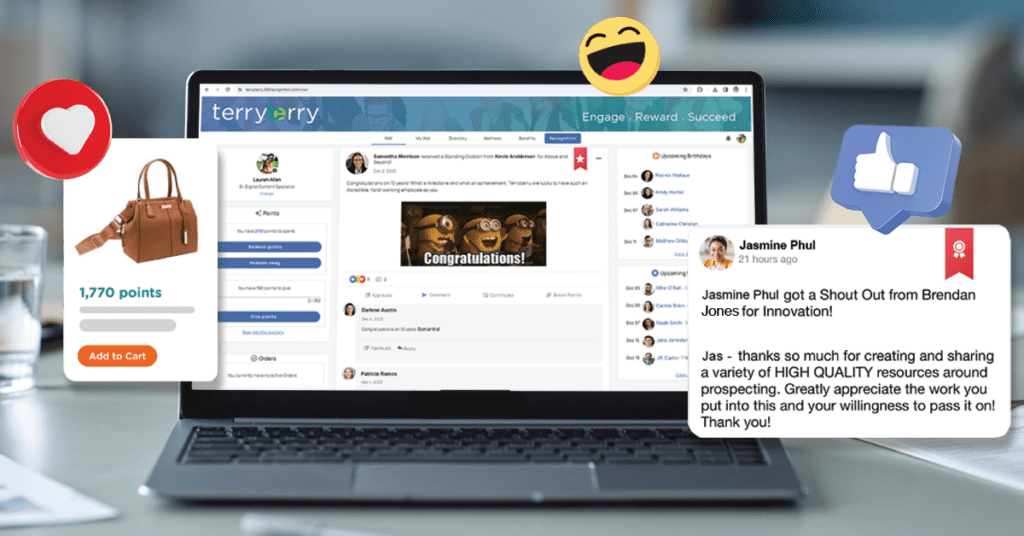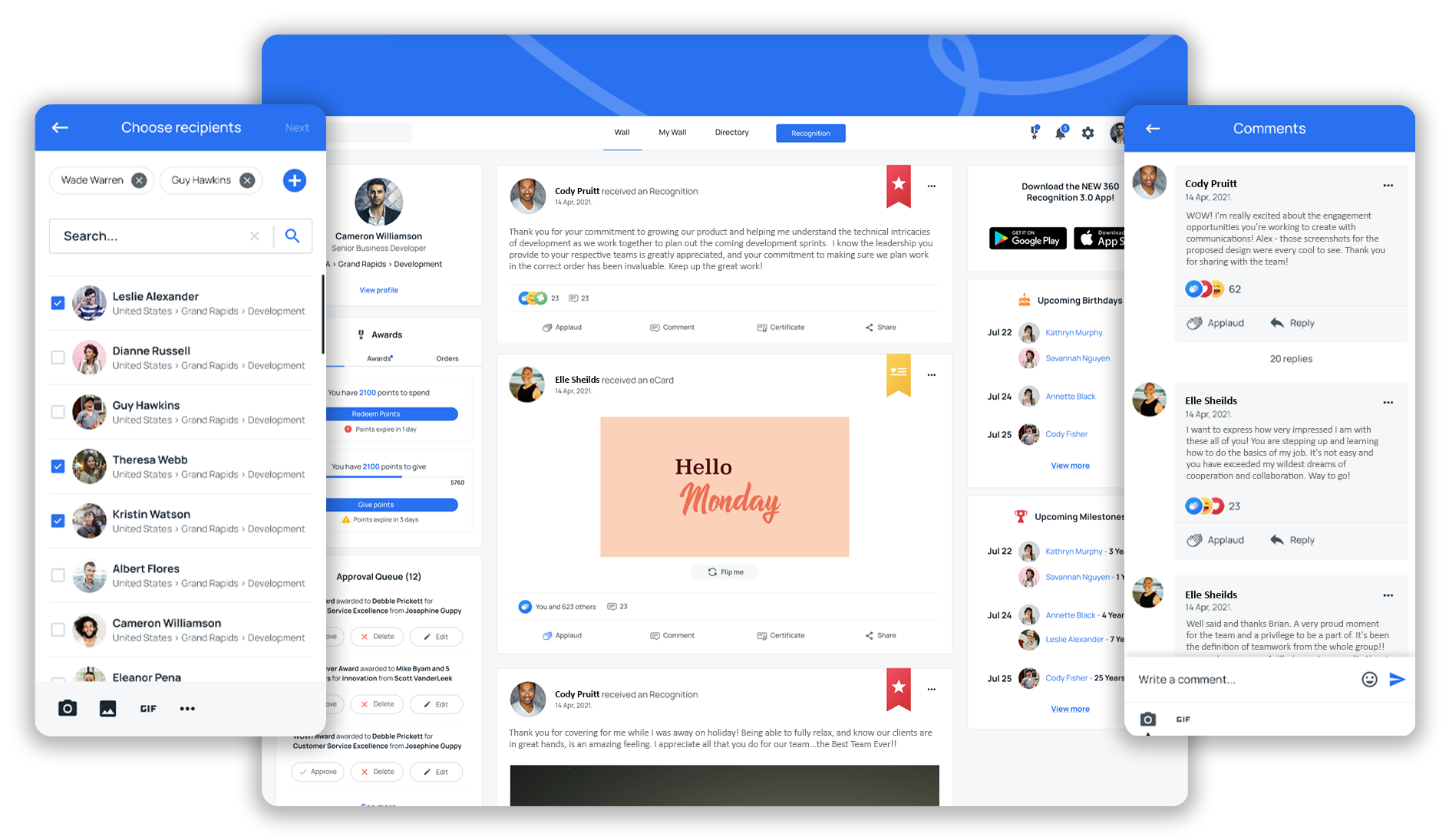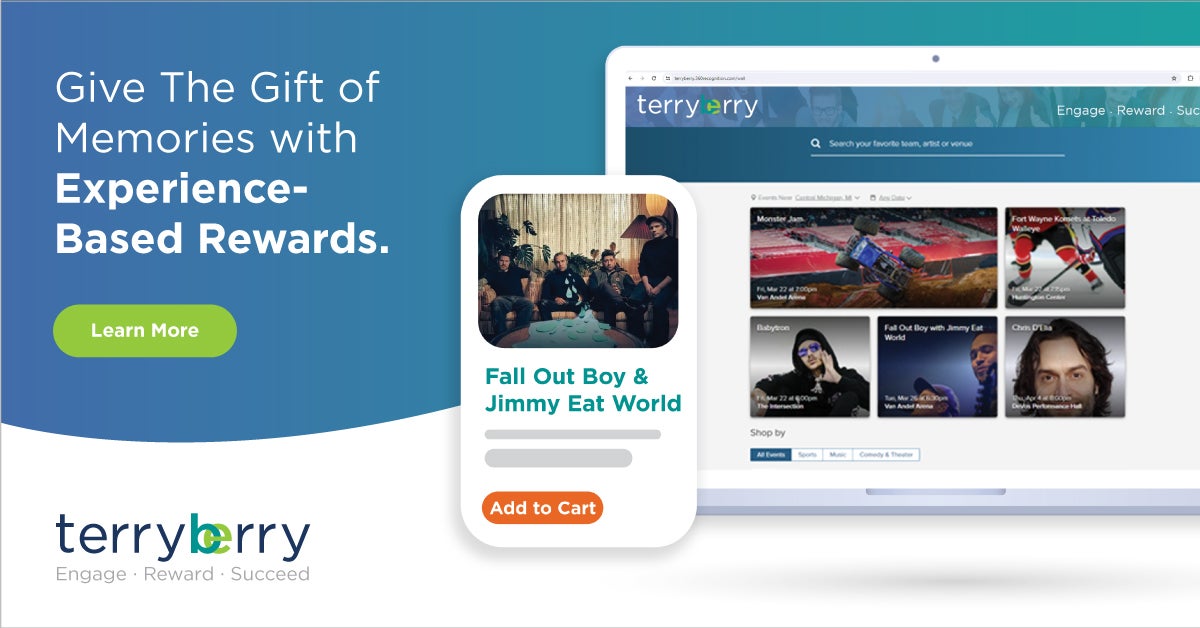November 27, 2024


Knowing the different forms of recognition is crucial for motivating employees and showing that you value their contributions.
This article explores eight forms of recognition, including public and private acknowledgment, monetary rewards, career advancement, and more. Discover practical examples and insights on effectively using these recognition strategies.
Key Takeaways
- Employee recognition enhances motivation and engagement, with key types including public, private, peer-to-peer, and leader-to-employee recognition.
- Monetary rewards, career advancement opportunities, and milestone celebrations effectively reinforce employee contributions and promote long-term commitment.
- Structured recognition programs and virtual strategies are essential in fostering a positive work environment, particularly in remote settings.
Key Types of Employee Recognition
Each type of recognition serves a unique purpose and can be tailored to meet the needs of different employees. Personalizing recognition according to what motivates each employee enhances its effectiveness and emotional connection.
Public Recognition
Public recognition involves highlighting achievements in front of an audience. This type of recognition can occur during meetings, conferences, social media posts, and company updates. Examples include shout-outs in team meetings, features in newsletters, and recognition during company events.
Public recognition can be so effective that a study by Bersin & Associates found that organizations with effective recognition programs have 31% lower voluntary employee turnover rates. This can lead to increased productivity and cost savings associated with recruitment and training.
Private Recognition
Private recognition refers to the acknowledgment of everyday achievements in a one-on-one setting, including recognition efforts. This method involves direct messaging, thank-you notes, and thoughtful gestures like handwritten notes.
Private recognition emphasizes thoughtful appreciation and sustained motivation through one-on-one acknowledgment.
Peer-to-Peer Recognition
Peer-to-peer recognition enhances camaraderie and teamwork within the organization. Formal peer recognition holds value as peers have firsthand knowledge of achievements and challenges. Popular forms of peer-to-peer recognition include people’s choice awards and peer-nominated awards.
Peer recognition software, or social recognition software, can facilitate peer-to-peer recognition, enhancing collaboration and appreciation among employees.
Leader-to-Employee Recognition
Manager-led recognition acknowledges team members’ accomplishments. When leaders recognize team members, it fosters a positive workplace culture and motivates team members.
Regular leader-to-employee recognition can lead to an 83% increase in employee engagement, boosting morale and inspiring others to aspire for acknowledgment.
Employee recognition software like Terryberry's can help remind employees to give recognition, like for anniversaries, birthdays, or when it's been more than 50 days since they've given recognition.
Structured Recognition Programs
Formal recognition uses structured methods to acknowledge contributions, maintaining engagement, productivity, and loyalty. Benefits include boosted morale, increased job satisfaction, and improved retention. Employee recognition programs serve as an incentive for employees to strive towards goals set by leadership.
Awards Ceremonies
Award ceremonies are a great way to build recognition into your company's culture. Consider an annual or quarterly event where leadership presents custom awards to team members. These awards can align with company values or they can be more humorous in nature, like Best Cubical Décor or Fastest Email Responder.
Recognition Software


Employee recognition software can streamline and automate the acknowledgment process, ensuring it is consistent and accessible. Employee recognition software fosters a culture of appreciation, making it easier for organizations to recognize employees while recognizing employees through a recognition program.
Ensuring consistency and accessibility in recognition enhances employee motivation and creates a positive workplace environment.
Informal Recognition Practices
Informal recognition, characterized by spontaneity and a lack of structure, is often a quick and low-cost appreciation method. Informal recognition makes employees feel genuinely valued, contributing to a positive workplace atmosphere.
Verbal Praise
Verbal recognition is just as it sounds. It refers to the act of verbally expressing gratitude, praise, or commendation through spoken words.
Verbal recognition can take various forms, from casual to formal recognition, including:
- Thank You: Simply expressing gratitude by saying "thank you" for a job well done or for going above and beyond expectations.
- Praise: Offering specific praise for a particular accomplishment, skill, or effort. This could include acknowledging a successful project completion, outstanding performance, or demonstration of a valuable skill.
- Acknowledgment: Recognizing an employee's efforts or contributions in a public setting, such as during a team meeting, company event, or in front of colleagues.
Written Communication
Written recognition celebrates individuals or groups through communication like handwritten notes, thank you notes, or detailed emails. Written praise boosts morale and motivation, offering a reference point during challenging times.
Milestone Celebrations
Milestone recognition and service awards are among the most common forms of employee recognition and, for many years, were often the primary method of acknowledging employee contributions.
Service awards are typically tied to work anniversaries, such as one year, five years, ten years, and beyond. Milestone awards, on the other hand, encompass a broader range of achievements. These may include reaching a sales target, completing a specific training program, celebrating a birthday, or achieving a significant tenure with the company.
Both types of recognition are important for building a well-rounded recognition program.


Work Anniversaries
Work anniversary recognition acknowledges an employee’s hire date, making them feel valued and appreciated, reinforcing longevity and consistency.
While you don't need to go all out for every work anniversary, it's a good idea to acknowledge in some way each year an employee stays with your company. This not only helps make the employee feel appreciated, but it can also help with retention.
Terryberry has found that simply recognizing and rewarding employees early (and often) can help drive employee engagement, job satisfaction, and in turn, retention. So, don't be afraid to celebrate employees' 6-month anniversary - if the role typically has high turnover, this could help improve that.
Celebrate employees' tenure with points given on a social recognition or reward platform, a shopping experience through an online storefront, or opt for a customized plaque or pin.
Project Completion
Completing major projects can also become important employee milestones to celebrate. This won't be doable for every project, but there are likely some notable projects worth acknowledging that pop up from time to time.
These might be projects like closing a major deal, launching a new website or brand, or launching a new platform. They likely took a lot of time and energy and deserve to be acknowledged.
Birthdays
Celebrating employee birthdays taps into personal recognition and boosts workplace positivity. Customized gifts based on the recipient’s interests can foster personal connections and enhance engagement in the workplace.
Virtual Recognition Strategies
With remote work becoming the norm, recognizing remote employees is critical to maintaining fairness and morale. Virtual recognition strategies bridge the gap between remote and on-site employees, fostering a cohesive recognition culture.
Virtual Shout-Outs
Virtual shout-outs publicly acknowledge employee achievements in virtual settings. Platforms like Terryberry's Be Recognized platform integrate recognition into daily workflows. Public acknowledgment during virtual meetings fosters appreciation and boosts motivation, too
Digital platforms are also a great way to enable real-time recognition by managers and peers, which is key for effective recognition.
Online Badges and Certificates
Online badges and certificates are tangible forms of recognition for skills and achievements. Tying these awards to company values is a great way to also reinforce the behaviors that are important to your company, such as innovation or collaboration.
Employees can share earned badges and certificates on internal networks and social media, boosting morale and recognition.
Monetary Rewards
Monetary rewards recognize and motivate outstanding employees, further incentivizing high performance. But remember, while monetary recognition can be effective, it’s also impersonal. So, it's important to know that this shouldn't be the basis of your employee engagement strategies. In fact, money should never be the only form of recognition you give your employees.
Too much focus on monetary rewards can also create a toxic environment, which is often counter-productive. It’s important to find a balance that works for your company culture.
Bonuses
Bonuses, as additional monetary compensation, reinforce positive behavior and encourage high performance. They significantly impact motivation and morale, making them an effective recognition tool. Salespeople can receive bonuses for meeting goals, while all staff can receive bonuses for year-end success. Even small bonuses can be effective in recognizing efforts.
Pay Raises
A pay raise, reflecting contributions and performance over time, is an effective way to formally recognize long-term contributions to the organization.
Incorporating pay raises into recognition strategies can boost overall motivation, job satisfaction, and retention.
Equity Awards
Equity awards, like stock options, are forms of non-cash compensation that give employees an ownership interest in the company. They're often used as part of a company's compensation strategy to attract, motivate, and retain talent. Equity awards align employees' interests with the success of the company by providing financial rewards linked to the company's performance or valuation.
Career Advancement Opportunities
Offering promotions and training programs shows employees that their company is invested in their growth and development. These opportunities can motivate employees by providing growth and professional development paths, rewarding their hard work and dedication.
Promotions
A promotion signifies the assignment of a new position, responsibility, or project to an employee. Providing a promotional reward indicates trust in the individual to take on more responsibilities, serving as a significant form of recognition.
Promotions powerfully recognize and reward employees, showing that their efforts are valued and appreciated, and shows the team which behaviors the company values.
Training Programs
Advanced training opportunities significantly boost recognition and career growth, developing employees’ skills. Offering training programs as recognition not only enhances skills but also demonstrates an organization’s commitment to employee growth.
Team-Based Recognition
Team recognition acknowledges collective achievements and efforts. Publicly acknowledging team accomplishments strengthens team bonds and fosters strong collaboration within teams. Encouraging peer-to-peer recognition builds support and collaboration, creating a positive work atmosphere.
Team Outings
Organizing team-building activities like sports events, hiking trips, or team lunches celebrates group successes and strengthens bonds through informal interactions.
Team outings also increase motivation and collaboration within the workplace, contributing to a more positive work environment.


Group Awards
Group awards like ‘Finance Team of the Quarter’ honor specific teams, promoting fairness and reducing competition to foster a collaborative environment.
Best Practices for Employee Recognition
Implementing a successful employee recognition program requires careful planning and execution. Here are some best practices for employee recognition that organizations can follow:
- Be Specific and Timely: Recognize employees as soon as possible after their achievement. Specific and timely recognition is more impactful and shows that you're paying attention to their efforts.
- Personalize Recognition: Tailor recognition to the individual preferences of employees. Some may appreciate public acknowledgment, while others may prefer private recognition.
- Encourage Peer-to-Peer Recognition: Create opportunities for employees to recognize each other. Peer-to-peer recognition can build camaraderie and a sense of community within the team.
- Use a Variety of Recognition Methods: Combine formal and informal recognition methods to keep the recognition program dynamic and inclusive. This can include awards, bonuses, thank-you notes, and verbal praise.
- Make Recognition a Part of the Company Culture: Integrate recognition into the daily operations and values of the organization. Regularly highlight achievements in team meetings and company communications.
By following these best practices, organizations can create a robust recognition program that effectively motivates and engages employees, leading to a more positive and productive work environment.
Summary
Employee recognition is a powerful tool that can transform your workplace. By understanding and utilizing the various forms of recognition, you can foster a positive and motivating environment where employees feel appreciated and are encouraged to perform at their best. Remember, a little recognition goes a long way in creating a happy and productive workforce.


